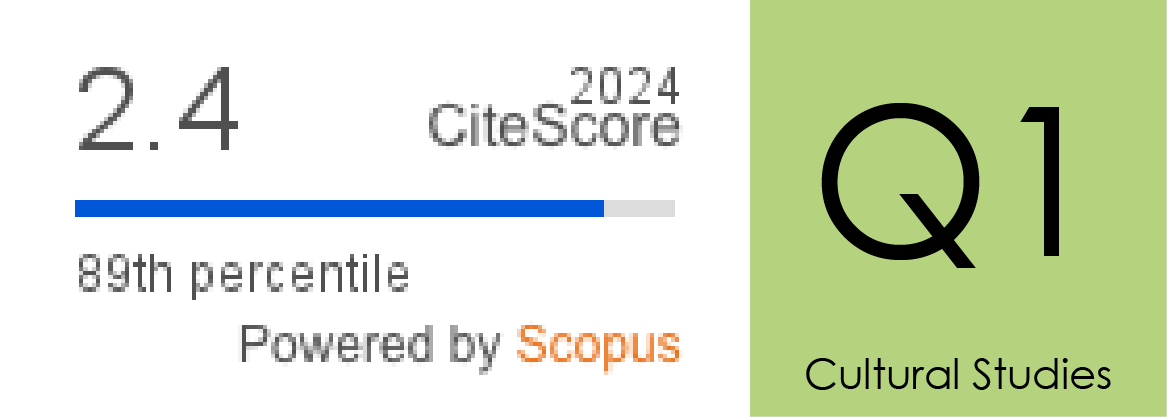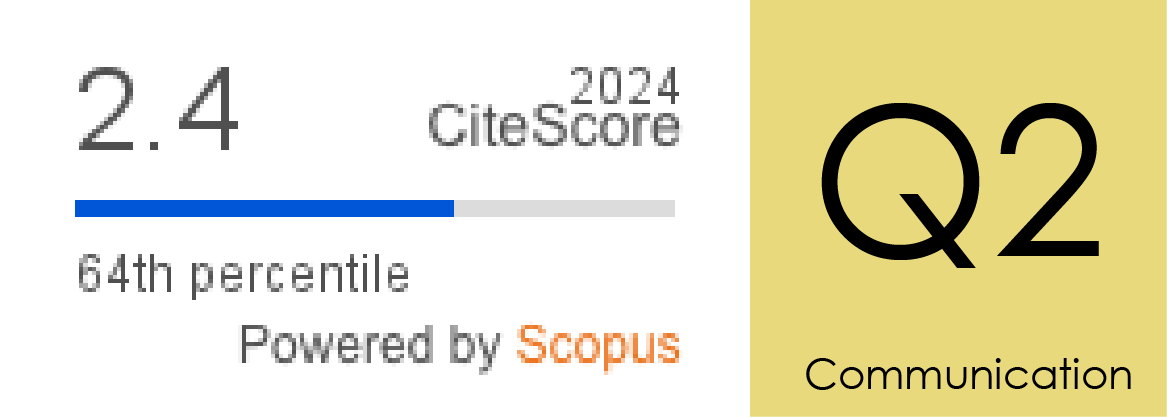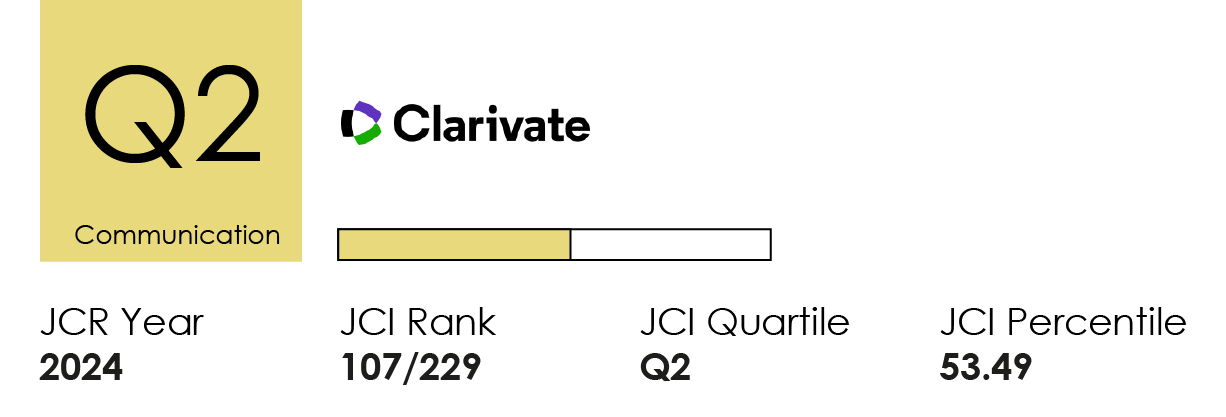El Efecto Matilda en la red de coautorías Hispanoamericana en Comunicación
DOI:
https://doi.org/10.14198/MEDCOM.18971Palabras clave:
Análisis de redes, Coautoría, Efecto Matilda, España, Género, Latinoamérica.Resumen
Investigaciones recientes con perspectiva de género han confirmado la pervivencia del "Efecto Matilda" en la ciencia, haciendo que las aportaciones y el papel de las mujeres sigan quedando relegados dentro de sus comunidades científicas. En este contexto, la propuesta que ocupa estas páginas se centra en comprobar si el fenómeno también se produce en la comunidad hispanoamericana de investigación en Comunicación, realizando para ello un análisis sociométrico sobre la red de coautorías. Los resultados señalan que pese a que tres de los cinco puestos más centrales de la red están ocupados por féminas, en términos generales se registran diferencias significativas que desplazan a las investigadoras a posiciones más periféricas. Del mismo modo, se ha detectado que las comunidades de investigación formadas por los distintos clústeres tienden a estar organizadas en torno a varones, confirmando así la presencia del Matilda effect en la red social de la disciplina de Comunicación. Cabe señalar que estas conclusiones se extrapolan a unos parámetros intelectuales (Comunicación) y geográficos (España y Latinoamérica) concretos, por lo que la puerta a estudios en otros ámbitos queda abierta.
Financiación
(Sin organismos financiadores)Citas
Aguado-López, E., Becerril-García, A. y Godínez-Larios, S. (2018). Asociarse o perecer: la colaboración funcional en las ciencias sociales latinoamericanas. Revista Española de Investigaciones Sociológicas, 161, 3-22. https://doi.org/ftgc
Aksnes, D. W., Piro, F. N., & Rørstad, K. (2019). Gender gaps in international research collaboration: A bibliometric approach. Scientometrics, 120, 747–774. https://doi.org/ggz2b7
Alonso, A., Diz, I. & Lois, M. (2016). Is gender mainstreaming helping women scientists? Evidences from research policies in Spain. Investigaciones Feministas, 7(2), 273-291. https://doi.org/ftgb
Ávila-Toscano, J., Vargas-Delgado, L., y Oquendo-González, K. (2020). Producción científica educativa, redes de autores y enfoques temáticos: Caso Universidad del Atlántico. Educación y Humanismo, 22(39), 1-17. https://doi.org/ftf9
Bain, O. & Cummings, W. (2000). Academe's Glass Ceiling: Societal, Professional‐Organizational, and Institutional Barriers to the Career Advancement of Academic Women. Comparative Education Review, 44(4), 493-514.
Batagelj, V. & Mrvar, A. (1998). Pajek: Program for large network analysis. Connections, 21(2), 47-57.
Benschop, Y. & Brouns, M. (2003). Crumbling ivory towers: Academic organizing and its gender effects. Gender, Work and Organization, 10(2), 194–212. https://doi.org/cmzdmz
Blickenstaff, J. C. (2005). Women and Science Careers: Leaky Pipeline or Gender Filter? Gender and Education, 17(4), 369–386.
Bordons, M., Aparicio, J., González-Albo, B. & Díaz-Faes, A. A. (2015). The relationship between the research performance of scientists and their position in co-authorship networks in three fields. Journal of informetrics, 9(1), 135-144.
Bornmann, L., Mutz, R. & Hans-Dieter, D. (2007) Gender differences in grant peer review: A meta-analysis. Journal of Informetrics, 1(3), 226–238. https://doi.org/d4nqfc
Calero, C., Buter, R., Cabello-Valdés, C. & Noyons, E. (2006). How to identify research groups using publication analysis: an example in the field of nanotechnology. Scientometrics, 66(2), 365–376.
Carter A.J., Croft, A., Lukas, D. & Sandstrom, G.M. (2018). Women's visibility in academic seminars: Women ask fewer questions than men. PLoS ONE, 13(9), e0202743. https://doi.org/cvgd
Castaño, C. (2010). Género y TIC. Presencia, posición y políticas. Barcelona: Editorial UOC.
Coate, K. & Howson, C.K. (2014). Indicators of esteem: gender and prestige in academic work. British Journal of Sociology of Education, 36(4), 567-585.
Conley, D. & Stadmark, J. (2012). Gender matters: a call to commission more women writers. Nature, 488(7413), 590. https://doi.org/f2zr2p
Collazo, F., Luna, M. E. y Vélez, G. (2010). Surgimiento de las prácticas científicas de colaboración en la ciencia mexicana con cobertura en los índices internacionales. Redes. Revista Hispana para el Análisis de Redes Sociales, 19(1), 143-167.
Davenport, E. & Snyder, H. (1995). Who cites women? Whom do women cite? An exploration of gender and scholarly citation in sociology. Journal of Documentation, 51(4), 404–410.
Dias, A., Ruthes, S., Lima, L., Campra, E., Silva, M., de Sousa, M. B. & Porto, G. (2019). Network centrality analysis in management and accounting sciences. RAUSP Management Journal.
Díaz-Campo, J. y Segado-Boj, F. (2017). Los conflictos de autoría en las revistas del Journal Citation Reports (JCR). Criterios éticos en las revistas de educación. BiD: textos universitaris de biblioteconomia i documentació, 39. https://doi.org/ftf8
Dion, M. L., Sumner, J. L. & Mitchell, S. M. L. (2018). Gendered Citation Patterns across Political Science and Social Science Methodology Fields. Political Analysis, 26(3), 312–327. https://doi.org/gd2j76
Faulkner, W. (2009). Doing gender in engineering workplace cultures. II. Gender in/authenticity and the in/visibility paradox. Engineering Studies, 1(3), 169–189. https://doi.org/dggzwv
Fernández-Quijada, D. y Masip, P. (2013). Tres décadas de investigación española en comunicación: hacia la mayoría de edad. Comunicar, 41, 15-24. https://doi.org/xzc
Fernández-Quijada, D., Masip, P. y Bergillos, I. (2013). El precio de la internacionalidad: La dualidad en los patrones de publicación de los investigadores españoles en comunicación. Revista Española de Documentación Científica, 36(2). https://doi.org/ftf7
Fell, C. B. & König, C. J. (2016). Is there a gender difference in scientific collaboration? A scientometric examination of co-authorships among industrial–organizational psychologists. Scientometrics, 108(1), 113-141.
Finn, N. (2016). Pseudonymous disguises: Are pen names an escape from the gender bias in publishing?. Greencastle, IN: DePauw University.
Freeman, L. C. (1978). Centrality in social networks: Conceptual Clarification. Social Networks, 1, 215-239.
Fryer, R. G. & Levitt, S. (2004). The causes and consequences of distinctly black names. Quarterly Journal of Economics, 5, 767–805.
Gallego-Morón, N. y Matus-López, M. (2020). Factores positivos en las trayectorias de las académicas e investigadoras argentinas. Cuestiones de género: de la igualdad y la diferencia, 15(1), 105-124.
Guil, A. (2008). Mujeres y ciencia: techos de cristal. Eccos Revista Científica, 10(1), 213-232.
Haba-Osca, J., Osca-Lluch, J. y González-Sala, F. (2019). Producción científica española en literatura desde una perspectiva de género a través de Web of Science (1975-2017). Investigación bibliotecológica, 3(79), 35-50.
Huang, J., Gates, A. J., Sinatra, R. & Barabási, A. (2020). Historical comparison of gender inequality in scientific careers across countries and disciplines. Proceedings of the National Academy of Sciences of the United States of America, 117(9), 4609–4616. https://doi.org/ggk89f
Jones, T. M., Fanson, K. V., Lanfear, R., Symonds, M. & Higgie, M. (2014). Gender differences in conference presentations: a consequence of self-selection? PeerJ, 2:e627. https://doi.org/ftf6
Kamada, T. & Kawai, S. (1989). An algorithm for drawing general undirected graphs. Information processing letters, 31(1), 7-15.
Karimi, F., Mayr, P. & Momeni, F. (2019). Analyzing the network structure and gender differences among the members of the Networked Knowledge Organization Systems (NKOS) community. International Journal on Digital Libraries, 20(3), 231-239.
Knobloch-Westerwick, S. & Glynn, C. J. (2013). The Matilda effect –Role congruity effects on scholarly communication: A citation analysis of Communication Research and Journal of Communication articles. Communication Research, 40(1), 3-26. https://doi.org/cj22g2
Knobloch-Westerwick, S., Glynn, C. J. & Huge, M. (2013). The Matilda Effect in Science Communication: An Experiment on Gender Bias in Publication Quality Perceptions and Collaboration Interest. Science Communication, 35(5), 603-625. https://doi.org/ggfnzw
Kretschme,r H., Kundra, R., Beaver, D. D. & Kretschmer, T. (2012). Gender bias in journals of gender studies. Scientometrics, 93(1), 135–150. https://doi.org/gc6mx7
Kumar, S. (2015). Co-authorship networks: a review of the literature. Aslib Journal of Information Management, 67(1), 55-73. https://doi.org/ftf5
Lariviére, V., Ni, C., Gingras, Y., Cronin, B. & Sugimoto, C. R. (2013). Bibliometrics: Global gender disparities in science. Nature, 211, 211–213. https://doi.org/qgf
Leaper, C. & Robnett, R. D. (2011). Women are more likely than men to use tentative language, aren’t they? A meta-analysis testing for gender differences and moderators. Psychology of Women Quarterly, 35(1), 129–142. https://doi.org/bgvwsd
Leifeld, P., Wankmüller, S., Berger, V. T., Ingold, K. & Steiner, C. (2017). Collaboration patterns in the German political science co-authorship network. PloS one, 12(4), e0174671.
Lincoln A. E., Pincus S., Koster, J. B. & Leboy, P. S. (2012). The Matilda effect in science: awards and prizes in the US, 1990s and 2000s. Social Studies of Science, 42(2), 307–320. https://doi.org/f35bf7
Martínez-Nicolás, M. (2020). La investigación sobre comunicación en España (1985-2015). Contexto institucional, comunidad académica y producción científica. Revista Latina de Comunicación Social, 75, 383-414. https://doi.org/fjbw
Moss-Racusin C. A., Dovidio, J. F., Brescoll, V. L., Graham, M. J. & Handelsman, J. (2012). Science faculty’s subtle gender biases favor male students. Proceedings of the National Academy of Sciences, 109(41), 16474–16479. https://doi.org/jkm
Newman, M. E. J. (2001). Scientific collaboration networks. I. Network construction and fundamental results. Physical Review E - Statistical Physics, Plasmas, Fluids, and Related Interdisciplinary Topics, 64, 016131. https://doi.org/bbp4b7
Otte, E. & Rousseau, R. (2002). Social network analysis: a powerful strategy, also for the information sciences. Journal of information Science, 28(6), 441-453.
Pell, A. N. (1996). Fixing the leaky pipeline: women scientists in academia. Journal of Animal Science, 74(11), 2843–2848.
Porter, M. A., Onnela, J. P. & Mucha, P. J. (2009). Communities in networks. Notices of the AMS, 56(9), 1082-1097.
Quevedo-Redondo, R. (2021). El estilo retórico femenino en la entrevista política. Una década de aplicación en Telva. Index.comunicación, 11(1), 271-295.
Rossiter, M. W. (1993). The Matthew Matilda effect in science. Social studies of science, 23(2), 325–341.
Sato, S., Gygax, P. M., Randall, J. & Mast, M. S. (2020). The leaky pipeline in research grant peer review and funding decisions: challenges and future directions. Higher Education, 2020. https://doi.org/ftf4
Segado-Boj, F., Martín-Quevedo, J. & Prieto-Gutiérrez, J. J. (2018). Attitudes toward Open Access, Open Peer Review, and Altmetrics among Contributors to Spanish Scholarly Journals. Journal of Scholarly Publishing, 50(1), 48-70. https://doi.org/ftf3
Segado-Boj, F., Prieto-Gutiérrez, J. J. y Díaz-Campo, J. (2021). Redes de coautorías de la investigación española y latinoamericana en Comunicación (2000-2019): cohesión interna y aislamiento transcontinental. Profesional de la Información, en prensa.
Stamhuis, I. H. (1995). A female contribution to early genetics: Tine Tammes and Mendel's laws for continuous characters. Journal of the History of Biology, 28(3), 495–531.
Sumner, J. L. (2018). The Gender Balance Assessment Tool (GBAT): A web-based tool for estimating gender balance in syllabi and bibliographies. PS: Political Science y Politics, 51(2), 396–400. https://doi.org/cpj5
Symonds, M. R. E., Gemmell, N. J., Braisher, T. L., Gorringe, K. L. & Elgar, M. A. (2006). Gender differences in publication output: towards an unbiased metric of research performance. PLoS ONE, 1(1). https://doi.org/bt4zft
Tinsley, C. H., Cheldelin, S. I., Schneider, A. K. & Amanatullah, E, T. (2009). Women at the bargaining table: pitfalls and prospects. Negotiation Journal, 25(2), 233–248. https://doi.org/cfwqxz
Udry, J. R. (1994). The Nature of Gender. Demography, 31(4), 561-573.
Vacarezza, N. L. (2018). Decir el propio género. Feminidades, usos del género gramatical y nombre propio. Cad. Pagu, 52(1), 1-32. https://doi.org/ftf2
Van Eck, N. J. & Waltman, L. (2010). Software survey: VOSviewer, a computer program for bibliometric mapping. Scientometrics, 84(2), 523-538. https://doi.org/cx2w6z
Vásárhelyi, O. (2020). Computational and relational understanding of gender inequalities in science and technology. (Tesis Doctoral). Central European University, Budapest, Hungría.
Walker, M. A. & Boamah, E. F. (2019). Making the invisible hyper-visible: Knowledge production and the gendered power nexus in critical urban studies. Human Geography, 12(2), 36-50.
Wenneras, C. & Wold, A. (1997). Nepotism and sexism in peer-review. Nature, 387(1), 341-343.
Zhang, N. & Li, J. (2020). Do neutral names have an influence on scientists' research impact. Proc Assoc Inf Sci Technol, 57, 1-12. https://doi.org/ftfz
Descargas
Estadísticas
Publicado
Cómo citar
Número
Sección
Licencia
Derechos de autor 2021 Francisco Segado-Boj, Juan-José Prieto-Gutiérrez, Raquel Quevedo-Redondo

Esta obra está bajo una licencia internacional Creative Commons Atribución 4.0.
Los autores y autoras que publican en esta revista están de acuerdo con los siguientes términos:
1 Derechos de autor. Los autores y autoras conservan sus derechos de autor, aunque ceden a la revista de forma no exclusiva los derechos de explotación (reproducción, distribución, comunicación pública y transformación) y garantizan a esta el derecho de primera publicación de su trabajo, el cual estará simultáneamente sujeto a la licencia indicada en punto 2. Los autores pueden establecer otros acuerdos adicionales para la distribución no exclusiva de la versión de la obra publicada en la revista, siempre que exista un reconocimiento de su publicación inicial en esta revista.
© Los autores.
2 Licencia. Los trabajos se publican en la revista sujetos a la licencia de Reconocimiento 4.0 Internacional de Creative Commons (CC BY 4.0); los términos se pueden consultar en https://creativecommons.org/licenses/by/4.0/
Esta licencia permite a terceros compartir (copiar y redistribuir el material en cualquier medio o formato) y adaptar (remezclar, transformar y crear a partir del material para cualquier finalidad, incluso comercial), siempre que se reconozca la autoría y la primera publicación en esta revista (Revista Mediterránea de Comunicación (RMC) / Mediterranean Journal of Communication (MJC), Universidad de Alicante, DOI de la obra), se proporcione un enlace a la licencia y se indique si se han realizado cambios en la obra.
3 Política de autoarchivo. Se recomienda a los autores que difundan sus trabajos a través de Internet para favorecer una circulación y difusión más rápidas y, con ello, un posible aumento en la citación y alcance entre la comunidad científica y académica, en las siguientes condiciones:
No se permite a los autores depositar en un repositorio institucional o temático, página web propia, etc., las versiones preprint (versión antes de ser evaluada) o postprint (versión evaluada y aceptada para su publicación) de sus trabajos antes de su publicación, pero sí el artículo final publicado (versión del editor).













